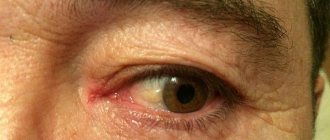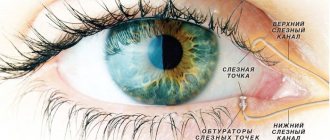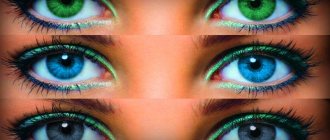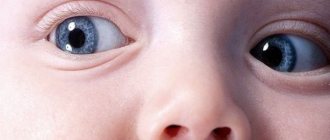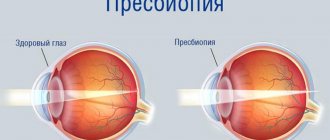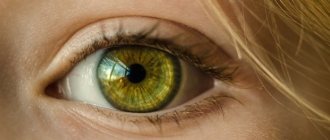What to do if your eyelid is red and swollen? These symptoms occur after injury, insect bites, and other causes. There are quite a lot of them. However, often the presence of both swelling and redness of the eyelids indicates the development of an inflammatory eye disease. Let's find out what diseases these signs appear in.
In this article
- Why is the upper eyelid swollen and red?
- Swollen and reddened eyelid: non-ophthalmological causes
- Eyelid swollen and red in the morning: causes
- The upper eyelid is swollen and red - what other reasons could there be?
- Swelling of the eye and redness of the eyelids - ophthalmological causes
- Swollen and reddened eyelids due to conjunctivitis - what to do?
- Upper eyelid becomes red and swollen due to blepharitis
- Swelling and redness of the upper eyelids with stye
- The eyelids are red and swollen due to chalazion - what to do?
- The eyelid is swollen and red - what to do?
Swollen and reddened eyelid: non-ophthalmological causes
The skin of the eyelids is very thin. In this regard, swelling appears primarily in this area of the face. The main cause of swelling is the accumulation of excess fluid in the intercellular space. This can happen with the following diseases:
- vegetative-vascular dystonia;
- hypothyroidism;
- allergy;
- oncology;
- dermatitis and other skin diseases;
- anemia;
- pathologies of the urinary system;
- abdominal dropsy;
- heart and vascular diseases.
The upper eyelids usually swell. However, these diseases, as a rule, are not accompanied by redness of the eyes. Both of these signs are observed only with allergies. Regardless of which of the factors listed above provoked swelling of the eyelids and hyperemia, the underlying ailment must be treated. If you stop only a symptom, it is most likely to appear again. Let's consider other causes of swelling of the eyelid or eye that are not associated with pathological processes.
Causes
Normally, redness of the skin is a temporary phenomenon, quickly passing after the irritating factor is eliminated (for example, caused by an emotional outburst). Pathological forms are characterized by persistence and duration; their main causes are:
- inflammatory and infectious diseases of viral or bacterial origin;
- skin burns (sun, radiation, chemical);
- allergic erythema is a consequence of exposure to allergens;
- autoimmune diseases (systemic lupus erythematosus).
Physiological factors for redness include ingestion or topical use of certain medications (for example, warming ointments), physical impact such as spanking or massage, and UV irradiation in the sun preceding tanning. A reflex change in skin color is caused by strong emotions (shame, anger), orgasm, and sometimes by hypnotic suggestion.
The mechanism of development of the pathological process is determined by the action of the irritating agent. Viruses or bacteria provoke inflammation and general intoxication, accompanied by fever and a rush of blood to small vessels. With burns and allergies, redness appears due to the release of histamine into the bloodstream, which dilates the capillaries and promotes stagnation of blood in them.
Eyelid swollen and red in the morning: causes
- Swelling of the upper eyelids often appears after sleep. This is usually caused by stagnation of fluid in the body, which can occur as a result of:
- drinking alcohol;
- late dinner consisting of too salty foods;
- drinking tea or water in large quantities before bedtime;
- overwork;
- insomnia;
- crying or stress.
Redness of the eye or eyelids due to swelling may indicate a large volume of fluid in the intercellular space. Hyperemia develops due to overcrowding of blood vessels, which occurs with severe edema. This symptom can also occur due to tears. A man rubs his eyes with his hands, and in the morning he discovers that they are swollen and red.
What should you do to get rid of these symptoms caused by natural causes? The only way to quickly get rid of swollen eyelids and red eyes is to use lotions, compresses or lymphatic drainage massage. It is also recommended to restore the balance of salts and fluids in the body. The swelling will not disappear completely. They will disappear only after you rest and get enough sleep.
Possible causes of stains
The reasons for the formation of spots on the eyelids can be very different. Among the common provocateurs for the development of atypical formations on the skin in the eye area are:
Composition and instructions for use of Sebozol shampoo
- avitaminosis;
- hereditary disposition;
- hormonal imbalance in the body;
- reaction to medication use;
- insect bite;
- reaction to cosmetics and hygiene products.
Very often, neoplasms itch, itch and are characterized by severe swelling. This significantly disrupts the patient’s usual life, and he strives to get rid of the tumor as quickly as possible, but this should not be done at home. Only if you are sure that you have been bitten by an insect, you can take antihistamines and delay visiting the doctor.
In most cases, spots are differentiated by their color, this allows one to eliminate half of possible diseases by visual inspection and speed up diagnosis. In total, medicine knows more than 50 diseases, the symptom of which is spots on the eyelids.
Red spots on the eyes
Red spots may indicate seborrheic dermatitis, allergies, demodicosis and hemangioma. Each of these diseases has accompanying symptoms by which you can recognize it. An allergic reaction, or, as it is commonly called, eczema, can occur due to irradiation, exposure to low temperatures and exposure to chemicals on the skin of the eyelid. The inflammatory process can also occur as a result of contact with aggressive substances, which are found in cosmetics, washing powders and detergents. Red spots can appear in both children and adults; eczema has no age preferences and manifests itself equally in everyone. It is painful for a person to blink, the eyelid swells greatly, waters, and the white gas turns red, vision may decrease, but the pathology has a short-term effect.
Violation of the intestinal microflora can manifest itself in the formation of red spots. It would seem very strange, but everything in the body is interconnected and pathogens that enter the intestines can manifest themselves in places with increased susceptibility. The skin on the eyelids is very delicate and thin, it is characterized by low local immunity, and accordingly turns red in the presence of a pathogen.
Among the accompanying symptoms of dysbacteriosis are stool disturbances, abdominal pain, as well as vomiting and deterioration in general condition.
Demodectic mange is a disease caused by a skin parasite called a mite. It settles into the skin, feeds on skin fiber and fat produced by the sebaceous glands. These mites are orange in color, but it is impossible to see them with the naked eye because they are very small. Redness appears if more than 3 mites infest the skin. One or two mites can live in human skin undetected for several months. Unsanitary conditions and prolonged exposure to the sun contribute to the spread of ticks.
Instructions for the use of Taktivin injections and analogues
You can recognize demodicosis by itchy spots that turn into papules with serous contents and do not go away for a long time. Sometimes the skin in the eyelid area may peel off.
Seborrheic dermatitis can develop due to excessive activity of the sebaceous glands and lack of hygiene. The disease is most often observed in infants and men. You can recognize this dermatitis by the spots that are very flaky and peel off in whole layers. The skin around the tumor is very itchy, but does not swell.
Hemangioma is a benign neoplasm. Externally, it resembles a pigment spot or a mole of an unnatural shape. You can recognize a hemangioma by applying pressure. It becomes white, then gradually regains its former color. If this factor is present, it is very important to visit an ophthalmologist, because hemangioma can degenerate into a malignant tumor, which requires intensive therapy.
Yellow spots
White and yellow spots are medically called xanthelasma. They are formed mainly in older people. Xanthelasmas are formed against the background of dysfunction of the stomach, liver and intestines. They can be recognized externally by their raised tubercles, soft and smooth to the touch. The formations have different sizes and shapes, it all depends on the intensity of the disturbance of fat metabolism in the body. The larger the tumor, the more complicated the situation. People with diabetes, obesity and food lovers with high amounts of cholesterol are at risk for the formation of xanthelasma.
Brown spots
Brown-colored formations are called chloasma; they can be transmitted genetically or develop against the background of diseases of the endocrine system, weak immunity, hormonal imbalance and chronic inflammatory processes in the body. This type of tumor is characterized by severe itching and irritation.
Interestingly, if the spot is caused by pregnancy, then it comes on its own after childbirth without medical intervention. In other cases, the pathology requires careful diagnosis and therapy.
If a spot appears on your eyelids, regardless of its color, you need to go to the doctor, because this is not a healthy signal from the body about a malfunction. Treating such a delicate area at home will not lead to anything good. It’s stupid to lose your sight and become disabled because of your passion for traditional therapy.
Swelling of the eye and redness of the eyelids - ophthalmological causes
Almost all eye diseases in which the inflammatory process begins cause redness of the eye, swelling of the eyelids and the area around the eye sockets. We list the most common ophthalmopathologies accompanied by inflammation of the tissues of the eyelids and eyeballs:
- conjunctivitis;
- blepharitis;
- barley;
- chalazion.
These diseases have very similar symptoms. Moreover, each of them is divided into many varieties. Only an ophthalmologist can make an accurate diagnosis. However, signs such as swelling of the upper eyelid and redness of the eyes are not enough to identify the disease and its cause.
Let us briefly describe these pathologies.
Diagnostics
Diagnosing one of the many types of erythema is quite difficult, since the characteristic redness of the skin and accompanying symptoms are characteristic of many diseases. For example, with scarlet fever, rubella or measles. After making a preliminary, primary diagnosis, the dermatologist prescribes specific tests:
- a serological test to detect the presence of antibodies to the virus that causes the disease;
- general blood test to determine the number of formed elements;
- allergy tests;
- taking exudate from pustules, if any.
It is also necessary to first exclude physiological causes of erythema and perform a differential diagnosis.
Swollen and reddened eyelids due to conjunctivitis - what to do?
Conjunctivitis is an inflammatory disease that affects the conjunctiva, or connective lining of the eye. There are many types of this disease. It is classified on several grounds, including reasons. Based on them, we can distinguish such types of conjunctivitis as bacterial, fungal, viral, chlamydial, allergic, etc. They differ in symptoms. The following features are common to them:
- burning and itching;
- lacrimation;
- photophobia;
- redness of the mucous membrane of the eye and eyelids;
- swelling;
- pain;
- discharge of mucus or pus.
Treatment of conjunctivitis is carried out with the help of medications prescribed by a doctor. Most often, inflammation of the conjunctiva occurs due to allergies or as a result of bacteria entering the connective membrane. Redness from the eyes and eyelids is eliminated with moisturizing drops. Swelling of the eyelids subsides only after the cause of the inflammatory process is suppressed. Conjunctivitis can develop in one or both eyes. Bacterial, fungal and viral types of this disease initially take a one-sided form. The allergy is almost always bilateral in nature - both eyes become red and swollen.
Upper eyelid becomes red and swollen due to blepharitis
Blepharitis is an inflammatory pathology that affects the eyelids. Inflammation can occur due to allergies, viruses, bacteria, fungi. Injuries can also cause inflammation. It begins after an irritant - an allergen or pathogenic microorganism - gets under the skin of the eyelids. When blepharitis develops, the following symptoms first appear:
- redness;
- edema;
- secretion;
- gluing eyelashes;
- dry eyes;
- formation of compaction in the thickness of the eyelid.
After a few days, secondary symptoms appear:
- photosensitivity;
- tearfulness;
- ghosting;
- formation of crusts along the edges of the eyelids;
- eyelash loss.
Inflammation of the upper eyelid is usually observed. The disease can be bilateral or unilateral. Often it first affects one side, and after some time it spreads to the other. Inflammation of the eyelid in one eye in most cases occurs due to infections. Bilateral blepharitis occurs due to allergies.
This disease is treated with ointments, gels and eye drops. The type of drug is prescribed based on the causes of blepharitis. It may become more complicated if treatment is not completed. Redness, swelling and other symptoms may disappear immediately after starting drug therapy. However, this does not mean that the disease has receded. Due to improper treatment, blepharitis can lead to conjunctivitis and keratitis.
Swelling and redness of the upper eyelids with stye
If the eyelid is swollen, red, and there is a feeling of compaction in it, barley may have occurred - an acute purulent inflammation that is localized in the sebaceous glands or hair follicles of the eyelids. It is accompanied by the following signs:
- itching and pain;
- lacrimation;
- sensation of a foreign body in the eye;
- swelling of the eye;
- hyperemia.
The eyelid swells very much, which can lead to complete closure of the eye. Also, barley often causes fever, headache, nausea, and general malaise. This indicates a serious infection of the body. The pathology mainly affects the eyelid of one eye. The bilateral form is diagnosed extremely rarely.
What should you do if you have stye? Often it matures and opens spontaneously. This process can be accelerated, but only after visiting an ophthalmologist who will prescribe the necessary medications. If the course is unfavorable, surgery must be performed.
The eyelids are red and swollen due to chalazion - what to do?
A chalazion is a benign compaction in the thickness of the cartilage of the upper eyelid (it rarely develops in the lower eyelids). It can increase to 5-6 mm in diameter. Swelling becomes pronounced. Symptoms such as itching, watery eyes, and redness of the eye appear. An enlarging chalazion causes diplopia. In more severe cases, the following is observed:
- severe swelling;
- throbbing pain;
- hyperemia of the eyelids and skin around the eye;
- increase in body temperature.
Chalazion is treated at the initial stage with medications and physiotherapy. If they do not help, surgery to remove the hailstones is prescribed.
Treatment methods
There are several treatment options that can be combined. The general rules for all types of treatment are to avoid contact with the allergen. In addition, you must refrain from using any cosmetics and strictly adhere to the medication schedule prescribed by your doctor.
Drug therapy
This treatment method uses systemic and local antiallergic drugs.
Suprastin, Diazolin or Diphenhydramine are excellent as first aid. Subsequently, in accordance with the doctor’s prescription, they drink Loratadine, Claritin, Telfast, Zyrtec and similar systemic antihistamines.
Local medications include various drops designed to eliminate itching, redness and swelling. Such drugs include Allergodil, Ketotifen, Alomide and others.
Particularly recommended drugs include:
- Faurine balm is based on herbal ingredients that gently relieve inflammation and itching and do not cause side effects.
- Azelastine is a drop suitable for the treatment of acute allergic conjunctivitis and acts almost instantly, which plays an important role in severe inflammatory processes.
- Lecrolin - help to quickly get rid of not only itching and burning, but also reduce the sensitivity of the organs of vision to bright light.
- Opatanol - drops that are good for conjunctivitis and keratitis.
Along with activated carbon, Polysorb or Filtrum can be used as energy sorbents.
Treatment with ointments
Various ointments with hormones can speed up the regeneration of the skin around the eyes, quickly relieve inflammation and eliminate other allergy symptoms.
Among the most common and effective ointments with hormones are:
- Dexamethasone. According to the instructions, this ointment is placed behind the lower eyelid in a thin strip. At the same time, during application of the ointment, the tube should not be allowed to come into contact with the mucous membrane and other surfaces of the eye in order to prevent infection of its contents. The duration of use of the product is no more than 3 weeks.
- Hydrocortisone. This drug relieves swelling well and reduces redness. Used with the same precautions as the previous drug.
Also, the most popular ointments include Lorinden, Advantan, Celestoderm and a number of others.
At the very beginning of treatment, these ointments are applied to the area around the eyes up to 5-6 times a day. And after the swelling and redness subside a little, the frequency of use is reduced to twice a day.
Important! All ointments with added hormones are prescribed exclusively by a doctor and are used for a short time.
If the allergic reaction is not very severe, then you can also use non-hormonal ointments, such as Bepanten, Actovegin, Fucidin and others.
Treatment with folk remedies
The most effective and popular folk remedies are compresses and lotions that relieve itching, burning and help cope with swelling.
In addition to lotions made from herbal decoctions, which are recommended when the first signs of allergy appear, traditional medicine also advises using fresh potatoes, cucumbers or apples. For that. To prepare a healing potion from them, you need to thoroughly wash the fruit and grate it. After this, the prepared pulp is placed on gauze and a compress is applied to the eyes for 15-20 minutes. Repeat the procedure up to 3 times a day.
You can also use a combination of vegetables and fruits to make purees.
Another effective remedy is a mixture of finely chopped onions and honey. To prepare the mixture, use one medium-sized onion and a tablespoon of honey. After mixing the ingredients, boil them for 5 minutes, then cool, spread on gauze and apply to the eyelids for 20-30 minutes.
Kalanchoe juice is also considered a good remedy for relieving swelling and itching. You should also soak a cotton pad in the juice squeezed from the leaves of the plant and wipe the inflamed eye(s) with it.
No less effective in combating an allergic reaction is a tincture of dill seeds, for the preparation of which the seeds are brewed with a glass of boiling water for 15 minutes, after which they are strained and used to wash the eyelids. Dill can be replaced with dried parsley. It is also poured with boiling water for 15 minutes, strained and used to wash the eyes.
Fresh birch sap also helps relieve inflammation. To reduce redness, apply a cotton swab dipped in birch sap to your eyes. The procedure time is 2-3 minutes.
In addition, washing the eyes with a soda solution, which is prepared using ordinary baking soda dissolved in water, helps reduce inflammation.
People have long used the healing properties of rye bread. Applying it to the eyes also helps reduce redness and swelling. However, before applying the bread to your eyes, place it in the refrigerator for a couple of hours.
Regular vegetable oil also helps relieve irritation. For these purposes, you can use sunflower, fir, olive, flaxseed and others (the main condition is that it should be as natural as possible, not refined).


